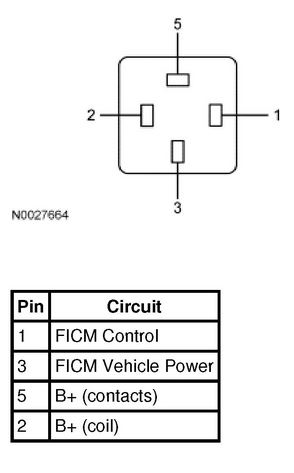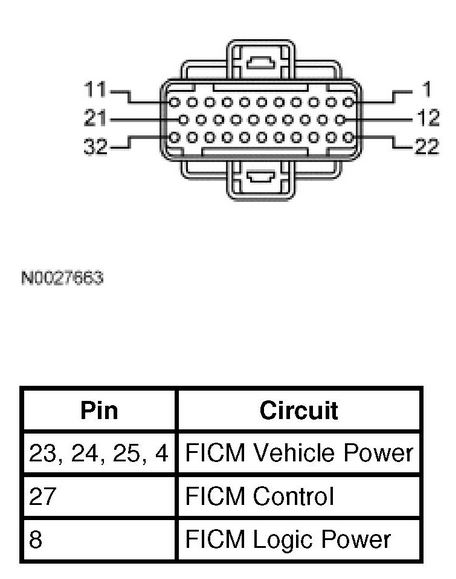Diagnostic Trouble Codes – FICM Codes P0611, P1378, P1379
Description
P0611 – Fuel Injection Control Module (FICM) Performance
P1378 – FICM Voltage Low
P1379 – FICM Voltage High
The FICM requires a 12-volt power source. The FICM receives power from the vehicle batteries through the FICM relay contacts each time the key is turned to the ON position. As the key is turned to the ON position, the FICM provides an internal ground to the coil side of the FICM relay. This closes the relay contacts and provides the FICM with the necessary power. The FICM is what controls the injectors and supplies the high-voltage current that operates the injectors. The FICM is fed 12 volts and turns it into 48 volts, so low voltage can be detrimental to the module.
Test Procedure
Step 1: Preliminary diagnosis for DTCs P0611, P1378, and P1379.
- Carry out a visual inspection.
- Retrieve and record all DTCs.
- Record the freeze-frame data.
- Clear the DTCs.
- Carry out the self-test.
- Is DTC P1378 or P1379 present?
Yes: For DTC P1378, go to Step 2. For DTC P1379, go to Step 6.
No: For DTC P0611 only, go to Step 7.
Step 2: Check the FICM supply voltage circuit.
- Possible Causes
- Loose connection
- Open circuit
- Relay
- Short to ground
- Charging system
- Key ON, engine OFF.
- Access the PCM and monitor the FICM_LPWR and FICM_VPWR PIDs.
Are the PID voltages between 10.5 and 15.5 V?
Yes–> No–>
Refer to Charging System – General Information to diagnosis the undercharging condition. Go to Step 3.
Step 3: Check the FICM voltage circuit for an open.
Key in OFF position.
FICM relay connector disconnected.
Key ON, engine OFF.
Measure the voltage between:
( + ) FICM Relay Connector, Harness Side ( – )
B+ (coil) – Pin 2 Ground
B+ (contacts) – Pin 5 Ground
Are the voltages greater than 10.5 V?
Yes–> No–>
Go to Step 4. Repair the open circuit. Clear the DTCs. Repeat the self-test.
Step 4: Check the FICM relay circuit for an open.
Key in OFF position.
FICM-C connector disconnected.
Measure the resistance between:
( + ) FICM Relay Connector, Harness Side ( – ) FICM-C Connector, Harness Side
FICM Vehicle Power – Pin 3 FICM Logic Power – Pin 8
Is the resistance less than 5 ohms?
Yes–> No–>
Go to Step 5. Repair the open circuit. Clear the DTCs. Repeat the self-test.
Step 5: Check the FICM relay control circuit for an open.
Measure the resistance between:
( + ) FICM Relay Connector, Harness Side ( – ) FICM-C Connector, Harness Side
FICM Control – Pin 1 FICM Control – Pin 27
Is the resistance less than 5 ohms?
Yes–> No–>
Install a new FICM relay. Clear the DTCs. Repair the open circuit. Clear the DTCs.
Repeat the self-test. Repeat the self-test.
Step 6: DTC P1379.
DTC P1379 indicates the FICM supply voltage is high.
Possible Causes
Charging system
Alternator
Clear the DTCs.
Carry out the self-test.
Is DTC P1379 present?
Yes–> No–>
Refer to Charging System – General Information to diagnosis the overcharging condition. Unable to duplicate the condition. Check for a loose connection and damaged or corroded terminals. Wiggle the harness to attempt to recreate the concern. Repair as necessary. Refer to Symptom Charts, if a driveability concern exists.
Step 7: Check the FICM power relay.
Carry out the FICM power relay component test. Refer to Component Testing. Does the FICM power relay pass the component test?
Yes–> No–>
Go to Step 8. Install a new FICM relay. Clear the DTCs. Repeat the self-test.
Step 8: Check the FICM supply voltage.
Key in OFF position.
FICM-C connector disconnected.
FICM Relay connector connected.
Key ON, engine OFF.
Measure the voltage between:
( + ) FICM-C Connector, Harness Side ( – )
FICM Vehicle Power – Pin 23, 24, 25, 4 Ground
Are the voltages greater than 10.5 V?
Yes–> No–>
Install a new FICM. Repair the open circuit. Clear the DTCs.
Clear the DTCs. Repeat the self-test. Repeat the self-test.


